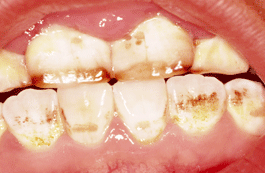Acerca de

Dental fluorosis
Dental fluorosis is a known adverse effect of fluoride overuse. Enamel or
dental fluorosis is a condition caused by 'excessive' intake of fluoride
over an extended period of time.
The most common symptom of dental fluorosis is a chalk-like discoloration
of teeth with white spots or lines on tooth enamel. In more severe cases
the affected areas have a yellow or brown discoloration. In extreme
forms, fluorosis may result in a pitted tooth surface.
Fluorosis is a cosmetic problem and not a dental disease. Teeth are strong and healthy, but the spots and stains left by fluorosis are permanent and may darken over time. Dental fluorosis can be cosmetically treated by a dentist by microabrasion or tooth bleaching.
Dental or Enamel fluorosis occurs only while the teeth are still developing under the gums, before their eruption. Fluoride causes dental fluorosis by damaging the cells that form the enamel, called ameloblasts. Damage to these cells results in a mineralization disorder of the teeth, whereby the porosity of the sub-surface enamel is increased.
Fluoride consumption can exceed the safe dose when a child drinks a lot of fluoride containing water in combination with other dietary fluoride sources (foods with high fluoride content), or by just swallowing fluoridated toothpaste.







Preventing Dental Fluorosis
Parents should take the necessary measures for preventing dental fluorosis on their children teeth :
Powdered or liquid concentrate infant formula should be mixed with water that is fluoride-free or contains low levels of fluoride
Do not use fluoride toothpaste until the child is two years old unless advised to do so by a dentist
For children age two and older, place only a pea-sized amount of fluoride toothpaste on the toothbrush at each brushing
Avoid toothpastes with flavors that may encourage swallowing
An adult should supervise the use of fluoride-containing dental products by children younger than six years old, and check that they do not swallow it.
Dental Fluorosis Treatment
Treatment options depend on the severity of dental fluorosis.
Tooth whitening - only for mild fluorosis cases. The whitening is achieved by the abrasion of the outer layer of the enamel in order to remove surface stains.
In cases of severe dental fluorosis the tooth enamel usually becomes porous, and tooth whitening methods are not recommended as treatment. Dental fluorosis treatment for severe cases of fluorosis requires covering the affected teeth with restorations, such as :
Composite bonding. After etching the enamel, a composite resin (with a color matching the other teeth) is "glued" on to the exterior of the tooth.
Porcelain veneers. Made out of porcelain, veneers form a ceramic shell over the surface of the tooth, covering the stains and discoloration caused by the dental fluorosis.
Tooth bonding and porcelain veneers are relativly expensive dental fluorosis treatments but they can provide excellent cosmetic results.
Fluorosis FAQ
How did my child get fluorosis?
Your child may have gotten dental fluorosis by ingesting too much fluoride in a number of forms. The excess fluoride can come from swallowing too much fluoride toothpaste, drinking canned or bottled drinks that contain fluoridated water, or taking too many of the fluoride drops or tablets prescribed for infants.
Your water supply also may have contained high levels of fluoride, which added to the problem. As a precaution, have your water supply checked.
But I thought fluoride was good for my child…
Fluoride is possibly the safest and most effective method available to prevent tooth decay, and teeth affected with dental flurosis are often more resistant to tooth decay. However, when ingested in excess, it can cause a negative cosmetic effect. Despite some early research suggesting a link between excessive fluoride consumption to conditions such as bone cancer or osteoporosis, to our knowledge, enamel fluorosis is the only negative side effect to inducing too much fluoride, and can be treated cosmetically.
My child has dental fluorosis. How can you help?
The damage that dental fluorosis causes to the internal matrix of the teeth is permanent. This damage is unfortunately irreversible. However, there are ways to hide the damage of enamel flurosis by treating the surface of the teeth so as to hide the discoloration.
Dental fluorosis treatment options vary and will depend in part on the severity of the fluorosis. Our options include:
Abrasion: Abrasion involves finely sanding off the outer layer of the enamel. It is a common approach when the fluorosis is mild. However, if the enamel fluorosis is of a more advanced severity, abrasion is probably not a good idea as it can bring to the surface of the teeth a highly-porous enamel that will be prone to attrition.
Composite bonding: Composite bonding first involves lightly roughening the area of the damaged enamel. After etching the enamel, a composite resin (with a color matching your teeth) is "glued" on to the exterior of the tooth.
Porcelain veneers/laminates: Made out of porcelain, veneers form a ceramic shell over the surface of the tooth.

